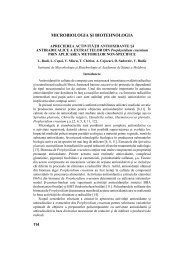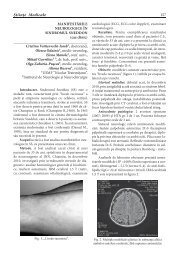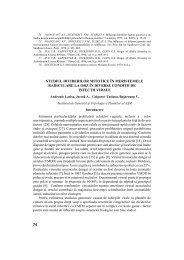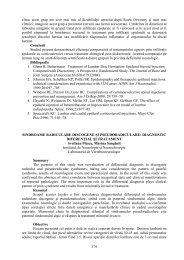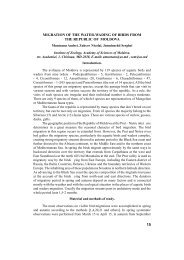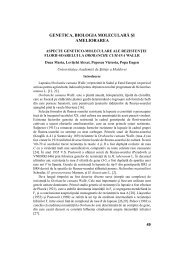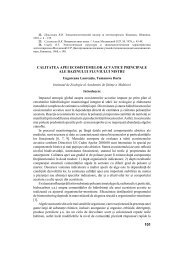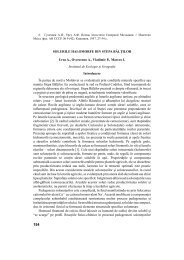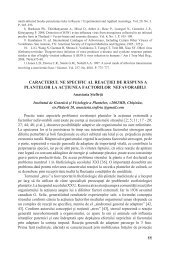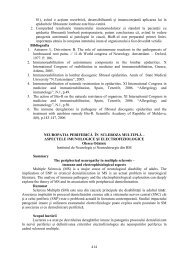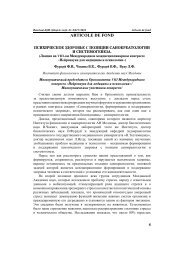BULETINUL ИЗВЕСТИЯ JOURNAL
BULETINUL ИЗВЕСТИЯ JOURNAL
BULETINUL ИЗВЕСТИЯ JOURNAL
Create successful ePaper yourself
Turn your PDF publications into a flip-book with our unique Google optimized e-Paper software.
Buletinul AŞM. Ştiinţele vieţii. Nr. 3(318) 2012<br />
Fiziologia şi Samocreatologia<br />
Introduction<br />
Leukaemia is a type of cancer of the blood or bone marrow characterised by an<br />
abnormal increase of immature white blood cells called “blasts”. Like other cancers,<br />
it results from mutations in the DNA. Certain mutations can trigger leukaemia by<br />
activating oncogenes or deactivating tumor suppressor genes, and thereby disrupting<br />
the regulation of cell death, differentiation or division.<br />
Since 1960s, an anthracycline antibiotic called Doxorubicin has been widely used<br />
in cancer chemotherapy. It is closely related to the natural product daunomycin, and like<br />
all anthracyclines, it works by intercalating DNA. However, Doxorubicin has a series of<br />
side-effects that strongly jeopardize patients’ lives. For instance, when the cumulative<br />
dose of Doxorubicin reaches 550 mg/m², the risks of developing cardiac side effects,<br />
including congestive heart failure, dilated cardiomyopathy, and death, dramatically<br />
increase. Doxorubicin cardiotoxicity is characterised by a dose-dependent decline in<br />
mitochondrial oxidative phosphorylation. Reactive oxygen species, generated by the<br />
interaction of Doxorubicin with iron, can afterwards damage the myocytes, causing<br />
myofi brillar loss and cytoplasmic vacuolisation [1, 2].<br />
For these reasons, more efforts are now focused on developing novel antitumor<br />
medicines with improved clinical effectiveness, broadened spectrum of activity, and<br />
with reduced general toxicity [3]. As DNA can interact with many bio-molecules and<br />
synthetic compounds, it is the main target for therapeutic treatment of cancer. Therefore,<br />
we have started a project directed towards the synthesis of different classes of compounds<br />
that can act as molecular inhibitors of cancer cells proliferation [4-6]. Particularly<br />
interesting are thiosemicarbazones, which have demonstrated potent cytotoxic activities<br />
against a series of murine and human tumor cells in culture [7]. In continuation of this<br />
approach, the present paper describes the chemical synthesis, characterisation and in<br />
vitro biological evaluation of N-(2,4-dimethylphenyl)hydrazinecarbothioamide and its<br />
azomethine derivatives. The composition and the structure of the synthesised substances<br />
have been determined by 1 H and 13 C NMR spectroscopy and X-ray diffraction. All<br />
substances were tested as inhibitors of human leukaemia (HL-60) cells growth.<br />
Materials and methods<br />
General. All reagents and chemicals have been obtained from commercially<br />
available sources, have been of analytical- or reagent-grade purity and have been used<br />
without further purifi cation. 1 H and 13 C nuclear magnetic resonance (NMR) spectra<br />
have been recorded at room temperature with a Bruker DRX 400 spectrometer. All<br />
chemical shifts ( 1 H, 13 C) are given in ppm versus SiMe 4 using DMSO-d 6 as solvent.<br />
X-ray diffraction has been performed with a Bruker X8 diffractometer.<br />
Antileukaemia bioassay. Human promyelocytic leukaemia cells HL-60 (ATCC),<br />
Rockville, MD, USA) were routinely grown in 90% suspension RPMI-1640 (Sigma<br />
Saint Louis, USA) containing L-glutamine (2 nM), antibiotics (100 IU penicillin/<br />
mL, 100 μg streptomycin/mL) and supplemented with 10% (v/v) foetal bovine serum<br />
(FBS), in a 5% CO 2 humidifi ed atmosphere at 37°C. Cells were currently maintained<br />
twice a week by diluting the cells in RPMI-1640 medium containing 10% FBS. The<br />
cell proliferation assay was performed by using 3-(4,5-dimethylthiazol-2-yl)-5-(3carboxymethoxyphenyl)-2-(4-sulfophenyl)-2H-tetrazolium<br />
(MTS) (Cell Titre 96<br />
Aqueous, Promega, USA), which allowed us to measure the number of viable cells. In a<br />
60



